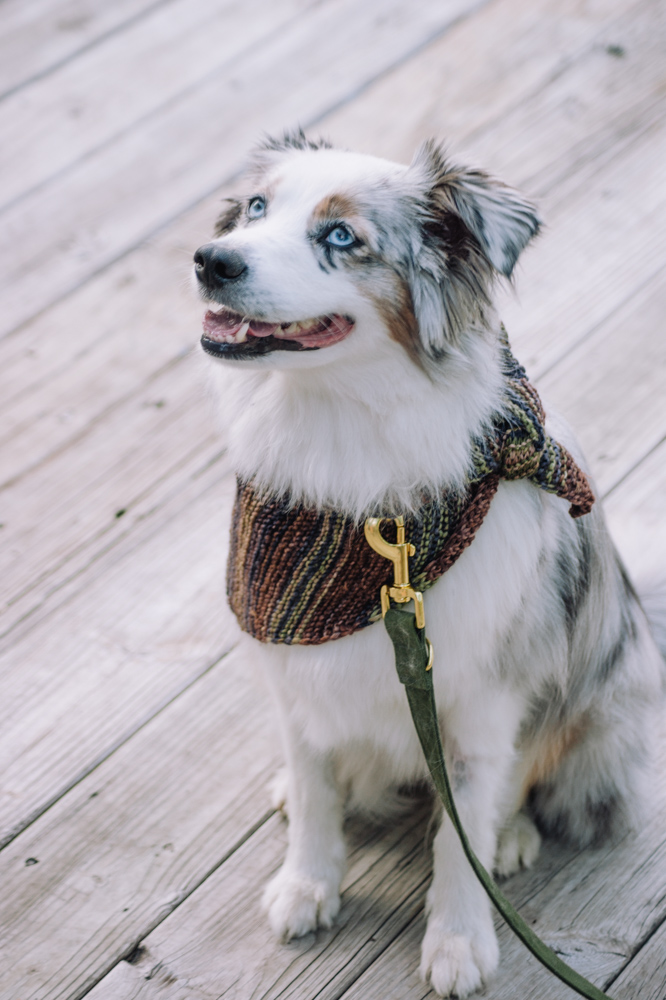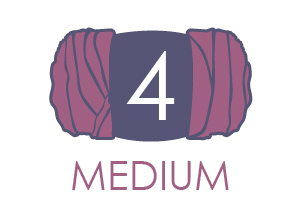
Love your pet and want to give him/her a stylish little accessory? This bandana is unique in that there’s a space for your leash clasp to hook onto the collar through the bandana. No more stopping mid-walk to pick up your dog’s bandana!
Skill Level: Easy
Size: 27″ / [69 cm] wingspan x 12″ / [30 cm] at deepest point as written
Gauge: 20 sts x 20 rows = 4″ [10 cm] in St st
Materials
 Yarn: Urth Uneek Worsted (100% Superwash Wool; 220 yards [201 meters]/100 grams): 4009 (1 skein)
Yarn: Urth Uneek Worsted (100% Superwash Wool; 220 yards [201 meters]/100 grams): 4009 (1 skein)
Needle: US size 8 (5.0 mm) 24″ circular
Notions: Tapestry needle, blocking wires and blocking board with pins (optional)
Pattern Notes
For a small or medium sized dog, when using a variegated yarn, use one skein divided into two balls. For a larger dog, use two separate skeins and follow pattern as a guide.
As written, this pattern used 90g of the 100g skein.
Yarn is not doubled during the knitting of the work; the yarn is divided into two separate balls to maintain striping of the long color repeat such in Uneek Worsted. If the yarn had not been divided into two balls, the result would have been color blocked rather than striped at the beginning and end of the work where there are fewer stitches per row. Using two separate balls presents thin stripes consistently throughout the work.
The two balls are defined as B1 and B2 in the pattern.
For the best fit on your dog, measure the dog’s neck, add 7” to the measurement to find the total length of the wingspan of the bandana. Divide this number in half and that becomes the point at which you begin decreasing the number of sts.
When switching balls of yarn on odd rows, the tension of the last st of the even row which was just used will be a bit lose, this can be pulled to create even tension when the yarn is used again 2 rows later.
The bandana was designed so the dog’s leash would pass through the bandana rather than go over it. If the dog prefers to wear his/her bandana with the widest point along his/her back rather than off to one side, work the Leash Locker rows in the middle of the bandana rather than 8” from the beginning of the work.
For a very short breed with a big neck, increase on every fourth row rather than every second row to create a thinner bandana when working the First Half and decrease ever fourth row rather than every second row when working the Second Half.
When casting on after making the Leash Locker, use a knitted cast on.
Pattern
First Half
Using B1, CO 1 st.
Row 1 (RS): Kfb. (2 sts)
Row 2 and all even rows for First Half of project (WS): Using ball as used on previous row, sl1, k to end.
Row 3: Sl1, using B2, k to last st, kfb. (1 st inc’d)
Row 5: Sl1, using B1, k to last st, kfb. (1 st inc’d)
Row 6: Rep Row 2.
Rep Rows 2-5 until work meas 8″ / [20 cm], ending with Row 6.
Leash Locker
Row 1 (RS): Sl1, using B2, k12, BO 6 sts, k to last st, kfb. (1 st inc’d at end)
Row 2: Sl1, k to st before bound off sts, using knitted cast on, CO 6 sts, k to end.
Row 3: Sl1, using B1, k to last st, kfb. (1 st inc’d)
Row 4: Sl1, k to end.
Rep Rows 3-6 as presented in First Half, changing balls of yarn every 2 rows until work meas 13.5″ / [34 cm] or 1/2 desired wingspan, ending with Row 6.
Second Half
Row 1: Sl1, using B2, k until 2 sts rem, k2tog. (1 st dec’d)
Row 2 and all even rows for Second Half of project (WS): Using ball as used on previous row, sl1, k to end.
Row 3: Sl1, using B1, k until 2 sts rem, k2tog. (1 st dec’d)
Row 4: Rep Row 2
Rep Rows 1-4 until 1 st rem.
BO st.
Finishing
Weave in ends.
As written, the bandana may be machine washed and dried. It is suggested the bandana is washed on gentle by machine and drier until damp. When damp, remove it from the drier and block to the desired dimensions using blocking wires and pins on an appropriately sized blocking board.
Dry out of direct sunlight, remove blocking wires and pins.

